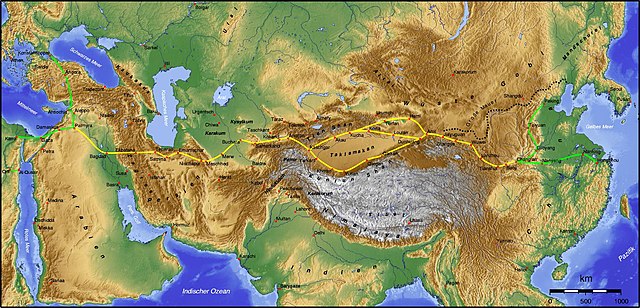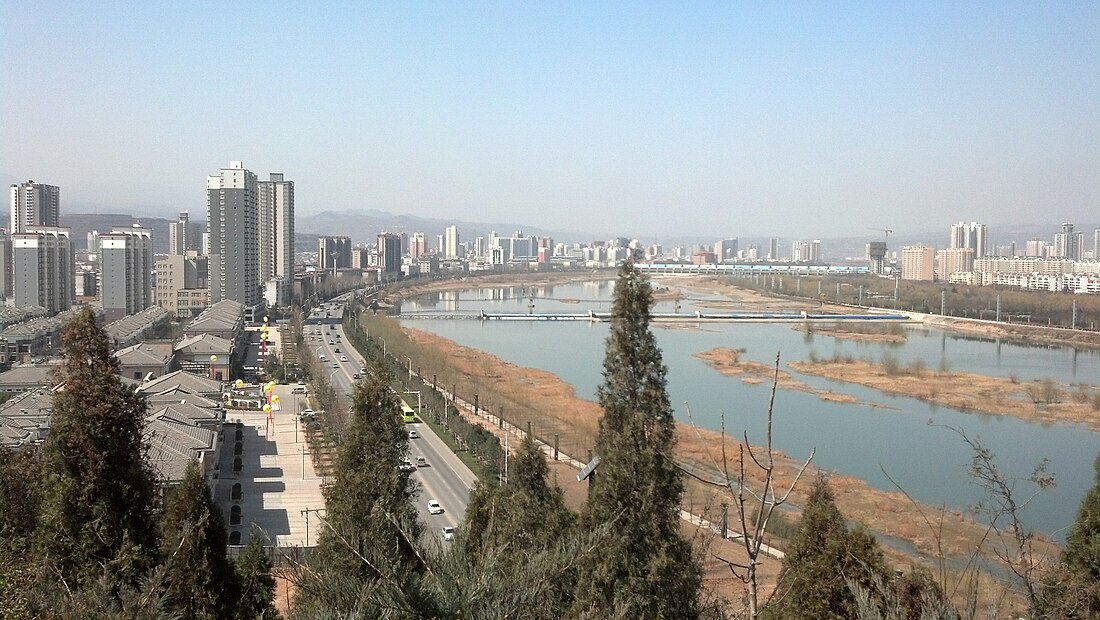Baoji
Prefecture-level city in Shaanxi, People's Republic of China From Wikipedia, the free encyclopedia
Baoji (simplified Chinese: 宝鸡; traditional Chinese: 寶雞; pinyin: Bǎojī; Mandarin pronunciation: [pàʊ.tɕí] ⓘ) is a prefecture-level city in western Shaanxi province, People's Republic of China. Since the early 1990s, Baoji has been the second largest city in Shaanxi.[4]
This article needs additional citations for verification. (May 2020) |
Baoji
宝鸡市 Pao-chi, Paochi, Paoki | |
|---|---|
 Baoji | |
 Location of Baoji Prefecture within Shaanxi | |
| Coordinates (Baoji government): 34°21′47″N 107°14′17″E | |
| Country | People's Republic of China |
| Province | Shaanxi |
| Founded | 2000 BC |
| Municipal seat | Jintai District |
| Area | |
| 18,159 km2 (7,011 sq mi) | |
| • Urban | 3,670.3 km2 (1,417.1 sq mi) |
| • Metro | 3,670.3 km2 (1,417.1 sq mi) |
| Elevation | 570 m (1,870 ft) |
| Population (2020 census)[1] | |
| 3,321,853 | |
| • Density | 180/km2 (470/sq mi) |
| • Urban | 1,862,118 |
| • Urban density | 510/km2 (1,300/sq mi) |
| • Metro | 1,475,962 |
| • Metro density | 400/km2 (1,000/sq mi) |
| GDP[2] | |
| • Prefecture-level city | CN¥ 179 billion US$ 28.7 billion |
| • Per capita | CN¥ 47,565 US$7,637 |
| Time zone | UTC+8 (China Standard) |
| Postal code | 721000 |
| Area code | 0917 |
| ISO 3166 code | CN-SN-03 |
| License Plate Prefix | 陕C |
| Website | www |
| Symbols | |
| Flower | Asiatic apple (Malus spectabilis)[3] |
| Tree | Lacebark pine (Pinus bungeana)[3] |
Geography
The prefecture-level city of Baoji had a population of 3,321,853 according to the 2020 Chinese census, inhabiting an area of 18,159 km2 (7,011 sq mi). The built-up (or metro) area made of 3 urban districts had a population of 1,475,962 inhabitants as of the 2020 Chinese census, with Fengxiang District not yet conurbated. Surrounded on three sides by hills, Baoji is in a valley opening out to the east. Its location is strategic, controlling a pass on the Qin Mountains between the Wei River valley and the Jialing River.
History
Summarize
Perspective
Thriving early in the Tang dynasty, it has roots to 2000 BC.[5] Today it is a large industrial center. Railways first reached Baoji in 1937 and have been key to its modern growth.

Passing through Baoji is the ancient Northern Silk Road, the northernmost route of about 2,600 kilometres (1,616 miles) in length, which connected the ancient Chinese capital of Chang'an to the West over the Wushaoling Mountain to Wuwei and emerging in Kashgar before linking to ancient Parthia.[6]
Baoji is considered the gateway between western and eastern China since most trains from Beijing, Shanghai and Xi'an pass through here on their way to Gansu, Sichuan, Xinjiang and Tibet (Lhasa). Famen Temple, home to one of Buddha's finger bones, is in Fufeng County. The Baoji area was home to the legendary Yandi, a forefather of the Han Chinese. His tomb is in the southern part of the city and his temple is in the north.
People who are interested in the Three Kingdoms of ancient China can visit Zhuge Liang's Memorial Temple, about 20 km (12 mi) from Baoji.
Ancient trackways
Mount Taibai still has some remaining traces of roadways built during the Three Kingdoms period (220−280 CE) which are all generally unusable due to decay. They remain a popular attraction because they were built by making wood plank bridges along the side of the mountain.
To the south of Baoji lies the beginning of the plank road into the Qin Mountains. There are also several natural sites such as the Jialing Jiang Fountainhead with its small waterfalls and forests. To the north is Bei Puo, a giant hill made of loess with a panoramic view of the city and a landscape dotted with small farming villages that offer local cuisine.
A number of Longshan archaeological sites have been found north of the Wei River near the North Silk Road.[7]
Baoji Bronze Museum
Baoji is home to the Baoji Bronze Museum which holds more than 120,000 pieces of cultural relics, primarily of Zhou dynasty descent.[8]
Administrative divisions

| Map | |||||
|---|---|---|---|---|---|
| Name | Hanzi | Hanyu Pinyin | Population (2010) | Area (km2) | Density (/km2) |
| Weibin District | 渭滨区 | Wèibīn Qū | 448,189 | 728 | 616 |
| Jintai District | 金台区 | Jīntái Qū | 394,538 | 332 | 1,188 |
| Chencang District | 陈仓区 | Chéncāng Qū | 595,075 | 2,517 | 236 |
| Fengxiang District | 凤翔区 | Fèngxiáng Qū | 483,471 | 1,179 | 410 |
| Qishan County | 岐山县 | Qíshān Xiàn | 459,064 | 855 | 537 |
| Fufeng County | 扶风县 | Fúfēng Xiàn | 416,398 | 751 | 554 |
| Mei County | 眉县 | Méi Xiàn | 299,988 | 863 | 348 |
| Long County | 陇县 | Lǒng Xiàn | 248,901 | 2,418 | 103 |
| Qianyang County | 千阳县 | Qiānyáng Xiàn | 123,959 | 959 | 129 |
| Linyou County | 麟游县 | Línyóu Xiàn | 90,728 | 1,806 | 50 |
| Feng County | 凤县 | Fèng Xiàn | 105,492 | 3,187 | 33 |
| Taibai County | 太白县 | Tàibái Xiàn | 50,928 | 2,780 | 18 |
Climate
| Climate data for Baoji, elevation 612 m (2,008 ft), (1991–2020 normals, extremes 1971–2010) | |||||||||||||
|---|---|---|---|---|---|---|---|---|---|---|---|---|---|
| Month | Jan | Feb | Mar | Apr | May | Jun | Jul | Aug | Sep | Oct | Nov | Dec | Year |
| Record high °C (°F) | 20.7 (69.3) |
27.0 (80.6) |
31.4 (88.5) |
36.2 (97.2) |
38.4 (101.1) |
41.7 (107.1) |
40.9 (105.6) |
41.6 (106.9) |
40.0 (104.0) |
33.0 (91.4) |
26.2 (79.2) |
23.2 (73.8) |
41.7 (107.1) |
| Mean daily maximum °C (°F) | 5.6 (42.1) |
9.5 (49.1) |
15.2 (59.4) |
21.9 (71.4) |
26.4 (79.5) |
30.8 (87.4) |
31.9 (89.4) |
29.6 (85.3) |
24.3 (75.7) |
18.8 (65.8) |
12.7 (54.9) |
7.0 (44.6) |
19.5 (67.1) |
| Daily mean °C (°F) | 0.6 (33.1) |
4.1 (39.4) |
9.5 (49.1) |
15.6 (60.1) |
20.1 (68.2) |
24.4 (75.9) |
26.3 (79.3) |
24.6 (76.3) |
19.5 (67.1) |
13.7 (56.7) |
7.4 (45.3) |
1.9 (35.4) |
14.0 (57.2) |
| Mean daily minimum °C (°F) | −2.8 (27.0) |
0.3 (32.5) |
5.1 (41.2) |
10.5 (50.9) |
14.9 (58.8) |
19.3 (66.7) |
22.0 (71.6) |
20.9 (69.6) |
16.2 (61.2) |
10.3 (50.5) |
3.8 (38.8) |
−1.5 (29.3) |
9.9 (49.8) |
| Record low °C (°F) | −13.9 (7.0) |
−11.4 (11.5) |
−5.3 (22.5) |
−1.7 (28.9) |
4.8 (40.6) |
10.0 (50.0) |
12.9 (55.2) |
13.2 (55.8) |
6.0 (42.8) |
−2.0 (28.4) |
−8.0 (17.6) |
−16.1 (3.0) |
−16.1 (3.0) |
| Average precipitation mm (inches) | 7.1 (0.28) |
10.3 (0.41) |
24.4 (0.96) |
40.9 (1.61) |
62.8 (2.47) |
80.1 (3.15) |
104.0 (4.09) |
111.4 (4.39) |
117.5 (4.63) |
56.7 (2.23) |
18.2 (0.72) |
4.6 (0.18) |
638 (25.12) |
| Average precipitation days (≥ 0.1 mm) | 4.2 | 4.6 | 7.1 | 7.2 | 10.2 | 9.9 | 10.6 | 11.1 | 12.6 | 10.6 | 6.0 | 3.3 | 97.4 |
| Average snowy days | 5.2 | 3.8 | 1.4 | 0.1 | 0 | 0 | 0 | 0 | 0 | 0 | 1.2 | 2.9 | 14.6 |
| Average relative humidity (%) | 58 | 59 | 58 | 58 | 59 | 60 | 66 | 72 | 76 | 74 | 69 | 61 | 64 |
| Mean monthly sunshine hours | 116.2 | 114.2 | 147.4 | 177.2 | 190.7 | 187.3 | 187.5 | 155.8 | 118.6 | 123.2 | 122.9 | 123.3 | 1,764.3 |
| Percentage possible sunshine | 37 | 37 | 39 | 45 | 44 | 43 | 43 | 38 | 32 | 36 | 40 | 40 | 40 |
| Source 1: China Meteorological Administration[9][10] | |||||||||||||
| Source 2: Weather China[11] | |||||||||||||
Economy
Industrial Zone
Established in 1992, Baoji Hi-Tech Industrial Development Zone was approved as a national hi-tech zone by State Council. It has a long-term planned area of 40 square kilometres (15 sq mi). The transportation system around the zone includes Xi'an Xianyang International Airport and National Highway 310. Its encouraged industries are auto parts, electronics, IT, pharmaceutical and bioengineering industry and new materials.[12]
Military
Baoji is the headquarters of the 21st Group Army of the People's Liberation Army, one of the two group armies that comprise the Lanzhou Military Region responsible for defending China's northwest borders.
Transportation
The G85 Yinchuan-Kunming Expressway, China National Highway 310, and G30 Lianyungang-Khorgas Expressway are major highways that run through Baoji.
The city is serviced by the Baoji South on the Xi'an-Baoji and Baoji-Lanzhou sections of the Xuzhou-Xinjiang high speed railway. The Longhai, Baocheng and Baozhong railways also call at Baoji railway station.[13]
A metro system is in the planning stages.
Education
College
- Baoji University of Arts and Sciences
- Baoji Vocational & Technical College (宝鸡职业技术学院)[14]
Sister cities
Japan
Other countries
 Vladimir, Russia
Vladimir, Russia Perchtoldsdorf, Austria
Perchtoldsdorf, Austria Belfort, France
Belfort, France Siddharthanagar, Nepal
Siddharthanagar, Nepal Elbląg, Poland
Elbląg, Poland Beirut, Lebanon
Beirut, Lebanon Ljubljana, Slovenia
Ljubljana, Slovenia
International agreements
 Aalst, Belgium
Aalst, Belgium
See also
References
External links
Wikiwand - on
Seamless Wikipedia browsing. On steroids.


